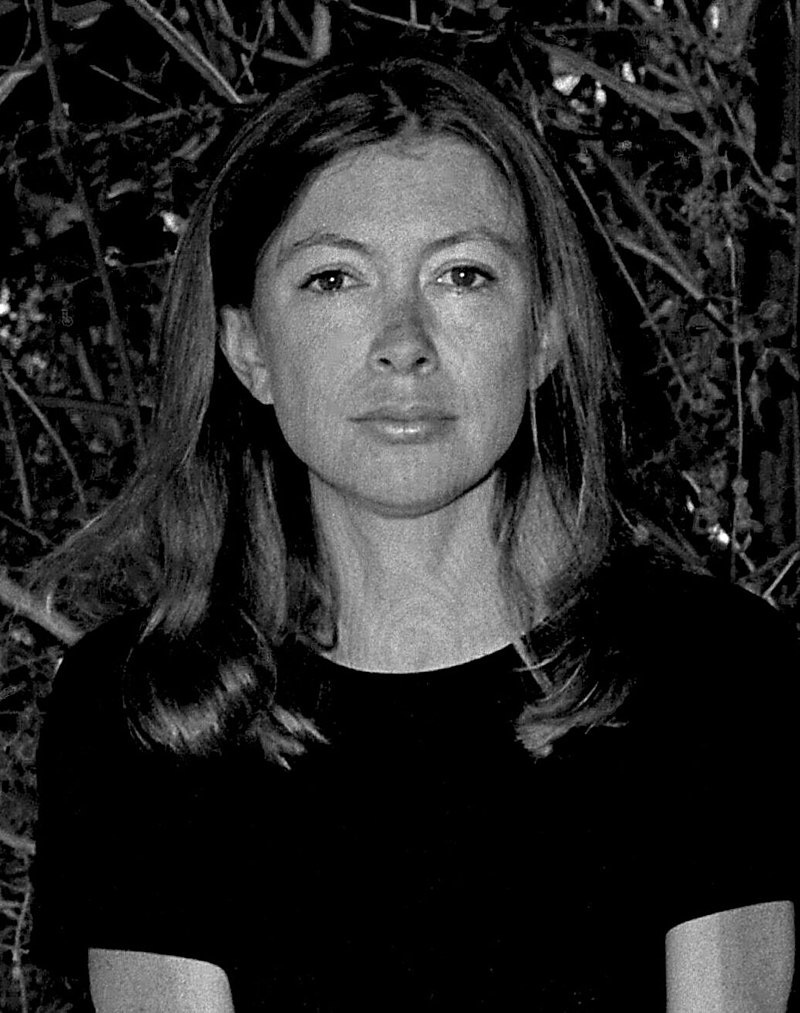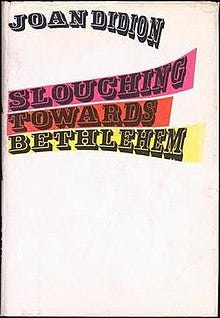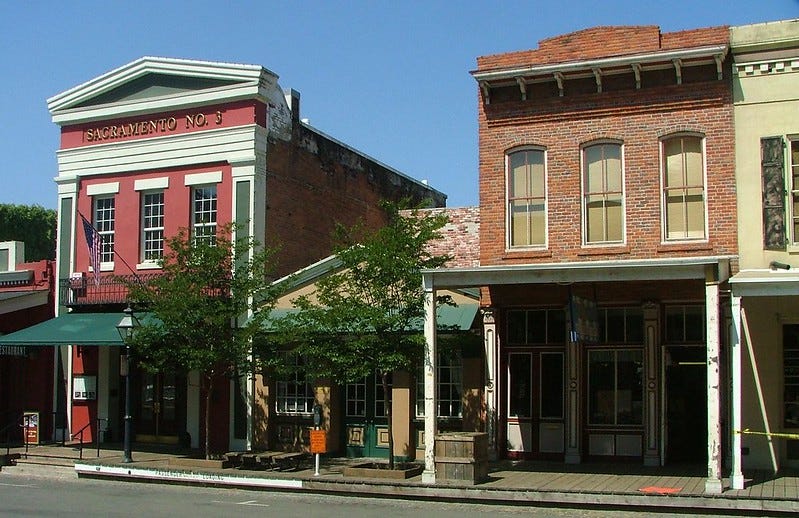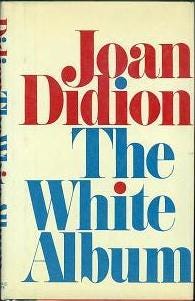I managed to not read Joan Didion until I was well into my 30s. Hers is a distinctive voice, one that I’ve come to appreciate. Sometimes I wish I’d encountered her prose earlier, although I wonder if I may not have been ready earlier. Reading an author prematurely often can ruin the experience.
For The Library this week, I’m revisiting her 1965 essay “Notes from a Native Daughter” found in Slouching Towards Bethlehem (1968). Read on!

Didion’s Position and Place
Didion (1934-2021) wrote novels and screenplays, as well as memoirs. But she is best known, rightfully, as an essayist. Two early collections—Slouching Towards Bethlehem (1968) and The White Album (1979)—gathered her best work of the 1960s and 1970s. Through them, readers simultaneously witness the unfolding of critical eras and a precise but creative prose stylist working at themes at once personal and specific. Those volumes represent each era’s zeitgeist . . . for a certain class of people.
Some critics fault Didion for that. Her work leans wealthy and white. California, so often the focus of Didion’s work, could be—and has been—rendered much differently by writers with different experiences, inclinations, and interests.
But it is Didion’s specific, idiosyncratic interest in the Californian past that draws me here. I considered several essays that illustrate that West Coast worldview but landed here largely because of the historical component. Many other angles are possible to view her writing from, but I’m drawn to her prose as a window into her peculiar California—and especially her view to the past.
Didion’s Changing Sacramento
“the truth about the place is elusive, and must be tracked with caution”
In “Notes from a Native Daughter” Didion reckoned with her hometown, Sacramento. More specifically, she attempted to wrap her mind around the changes Sacramento had experienced in the post-World War II era, a transformation that unsettled her. By the end, the essay becomes, in some ways, her meditation on the (ir)relevance of history once change occurs.
Although the Maidu and Miwok hold much deeper claims to the Sacramento region, Didion’s roots were not shallow. Her pioneer family (some of whom were part of the Donner Party, but split off and went to Oregon) features in much of her writing, including Where I Was From (2003). Which is to say, she takes her history, and California’s past, seriously, because she claims a stake in it.
But the past also made her melancholic:
my own childhood was suffused with the conviction that we had long outlived our finest hour.
Didion’s burden seems to be that she was living after the good ol’ days for Sacramento and its surroundings.
California’s Central Valley was “a giant outdoor hothouse,” but its character was morphing in her lifetime. Sacramento might have changed the most, although Didion insisted it remained the least like the Valley of any Valley town. Still the dramatic change spelled a new era for the Valley.
Defense contractors, who read the San Francisco Chronicle instead of either of Sacramento’s newspapers, arrived and furnished new accents to conversations. They drove the demand that transformed ranches into housing tracts.
Land dominated conversations in Sacramento, but they always were about selling and building, not growing crops or obtainin water.
This dismayed Didion:
All that is constant about the California of my childhood is the rate at which it disappears.
This nostalgia and conservative reaction to change is common in Didion’s early work especially. But it is not uncommon elsewhere: Who among us couldn’t make a similar statement about our childhood home changing beyond recognition?
But perhaps it was even worse than a typical lament that the town of our childhood is different in our adult years.
The “solid citizens” of Sacramento, Didion said, sensed they were functionally obsolete now that the newcomers were refashioning the place. This meant the people of Sacramento were “paralyzed by a past no longer relevant.”
Didion looked askance at these newcomers. They didn’t know her town, her valley, her ancestors. Because they didn’t know that past, they didn’t know what they were seeing in “New” Sacramento was artifice. New names, for instance, bore no connection to the place’s past.
This all had consequences. With their ignorance of the place and its past, the new aerospace engineers were lost, thought Didion.
They will have lost the real past and gained a manufactured one, and there will be no way for them to know.
Response
In part I share Didion’s reaction. When people cannot tell a real past from a manufactured one, they are adrift in a world without reference points. They misunderstand their place. They make judgments based on something other than firm ground. They are liable to fall for idealized, erroneous explanations. One does not have to look far in 2024 to find people who are moored to an erroneous history.
In the middle of her essay, Didion asked, “Which is the true California? That is what we all wonder.”
Are some pasts more real, truer, than others? In the sense that some facts are true and other details are made up, then, sure, there are truer pasts. But in the sense that some residents with deeper or shallower roots make different claims, truer claims, on a place, I’m not so sure.
Lately, we hear claims about who “real Americans” are. These claims to my ear always are about the past. They are answering Didion’s question about what the true California (or fill-in-your-blank) is, and the answer is usually narrow and limited.
The truth about places is elusive, as Didion wrote. But it isn’t found in giving up the past.
Post-Script: Didion’s Prose
I cannot leave this without a comment about Didion’s writing.
Her writing often gleams. And although she is not an environmental writer, she can evoke place superbly:
It is just as hot in the summertime, so hot that the air shimmers and the grass bleaches white and the blinds stay drawn all day, so hot that August comes on not like a month but like an affliction; it is just as flat, so flat that a ranch of my family’s with a slight rise on it, perhaps a foot, was known for the hundred-some years which preceded this year as “the hill ranch."
Oh, to write a sentence like that!
Closing Words
Relevant Reruns
I’ve not written before about something like Didion’s essay in Taking Bearings, but this one is at least about a California author. To consider this piece of mine as related to Didion’s is taking considerable liberties, but some of the subjects of the article were experiencing their own struggles with nostalgia in the context of smokejumping and changing fire policy.
New Writing
A historical article I wrote about timberland ownership in Washington is up at HistoryLink. Take a look!
As always, you can find my books, and books where some of my work is included, at my Bookshop affiliate page (where, if you order, I get a small benefit).
Taking Bearings Next Week
Next week is The Wild Card again. Stay tuned!







I've been perusing Didion's California essays, especially about history and family, and I enjoyed your read on them.